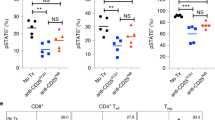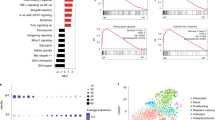Abstract
Lymphoma cells mobilize many mechanisms to evade the immune system. There is substantial evidence that CD4+CD25+ regulatory T cells (Tregs) play a key role in the control of immune evasion. Tregs can transfer cyclic adenosine monophosphate (cAMP) to effector T cells, suggesting an association between Tregs' immune-evasion role and the intracellular cAMP pathway. In this study, we used A20 B-cell lymphoma mice as aggressive tumor models to investigate the mechanism of the depletion of Tregs by low-dose cyclophosphamide (CY, 20 mg/kg). The tumor-bearing mice had longer survival times and slower tumor growth rates following treatment with CY, but its effects were temporary. Along with the depletion of Tregs by low-dose CY treatment, the expression of interleukin-2 (IL-2) in T effector cells increased, and intracellular cAMP concentrations in immune cells decreased. Our study demonstrates the ability of low-dose CY to reverse Tregs-mediated immune evasion in a mouse model. The changes in intracellular cAMP concentrations correlated with the upregulation of effector T cells and the downregulation of Tregs, indicating the close association of cAMP analogs and low-dose CY in the immune therapy of B-cell lymphoma.
This is a preview of subscription content, access via your institution
Access options
Subscribe to this journal
Receive 12 digital issues and online access to articles
$119.00 per year
only $9.92 per issue
Buy this article
- Purchase on Springer Link
- Instant access to full article PDF
Prices may be subject to local taxes which are calculated during checkout





Similar content being viewed by others
References
Elpek KG, Lacelle C, Singh NP, Yolcu ES, Shirwan H . CD4+CD25+ T regulatory cells dominate multiple immune evasion mechanisms in early but not late phases of tumor development in a B cell lymphoma model. J Immunol 2007; 178: 6840–6848.
Ge X, Wang X . Role of Wnt canonical pathway in hematological malignancies. J Hematol Oncol 2010; 3: 33.
Wan YY . Regulatory T cells: immune suppression and beyond. Cell Mol Immunol 2010; 7: 204–210.
Loddenkemper C, Hoffmann C, Stanke J, Nagorsen D, Baron U, Olek S, et al. Regulatory (FOXP3+) T cells as target for immune therapy of cervical intraepithelial neoplasia and cervical cancer. Cancer Sci 2009; 100: 1112–1117.
Qin FX . Dynamic behavior and function of Foxp3+ regulatory T cells in tumor bearing host. Cell Mol Immunol 2009; 6: 3–13.
Schreiber TH . The use of FoxP3 as a biomarker and prognostic factor for malignant human tumors. Cancer Epidemiol Biomarkers Prev 2007; 16: 1931–1934.
Finn OJ . Cancer immunology. N Engl J Med 2008; 358: 2704–2715.
Sojka DK, Huang YH, Fowell DJ . Mechanisms of regulatory T-cell suppression—a diverse arsenal for a moving target. Immunology 2008; 124: 13–22.
Sakaguchi S, Sakaguchi N, Shimizu J, Yamazaki S, Sakihama T, Itoh M et al. Immunologic tolerance maintained by CD25+ CD4+ regulatory T cells: their common role in controlling autoimmunity, tumor immunity, and transplantation tolerance. Immunol Rev 2001; 182: 18–32.
Shah W, Yan X, Jing L, Zhou Y, Chen H, Wang Y . A reversed CD4/CD8 ratio of tumor-infiltrating lymphocytes and a high percentage of CD4+FOXP3+ regulatory T cells are significantly associated with clinical outcome in squamous cell carcinoma of the cervix. Cell Mol Immunol 2010; 8: 59–66.
Powrie F, Maloy KJ . Immunology. Regulating the regulators. Science 2003; 299: 1030–1031.
Bopp T, Becker C, Klein M, Klein-Hessling S, Palmetshofer A, Serfling E et al. Cyclic adenosine monophosphate is a key component of regulatory T cell-mediated suppression. J Exp Med 2007; 204: 1303–1310.
Li B, Greene MI . Special regulatory T-cell review: FOXP3 biochemistry in regulatory T cells—how diverse signals regulate suppression. Immunology 2008; 123: 17–19.
Bjorgo E, Tasken K . Role of cAMP phosphodiesterase 4 in regulation of T-cell function. Crit Rev Immunol 2006; 26: 443–451.
Bazhin AV, Kahnert S, Kimpfler S, Schadendorf D, Umansky V . Distinct metabolism of cyclic adenosine monophosphate in regulatory and helper CD4+ T cells. Mol Immunol 2010; 47: 678–684.
Mizrachi K, Aricha R, Feferman T, Kela-Madar N, Mandel I, Paperna T et al. Involvement of phosphodiesterases in autoimmune diseases. J Neuroimmunol 2010; 220: 43–51.
Huang B, Zhao J, Lei Z, Shen S, Li D, Shen GX et al. miR-142-3p restricts cAMP production in CD4+CD25− T cells and CD4+CD25+ TREG cells by targeting AC9 mRNA. EMBO Rep 2009; 10: 180–185.
Bodor J, Fehervari Z, Diamond B, Sakaguchi S . Regulatory T cell-mediated suppression: potential role of ICER. J Leuk Biol 2007; 81: 161–167.
Yaqub S, Tasken K . Role for the cAMP-protein kinase A signaling pathway in suppression of antitumor immune responses by regulatory T cells. Crit Rev Oncog 2008; 14: 57–77.
Nakahara T, Uchi H, Lesokhin AM, Avogadri F, Rizzuto GA, Hirschhorn-Cymerman D et al. Cyclophosphamide enhances immunity by modulating the balance of dendritic cell subsets in lymphoid organs. Blood 2010; 115: 4384–4392.
Brode S, Cooke A . Immune-potentiating effects of the chemotherapeutic drug cyclophosphamide. Crit Rev Immunol 2008; 28: 109–126.
Motoyoshi Y, Kaminoda K, Saitoh O, Hamasaki K, Nakao K, Ishii N et al. Different mechanisms for anti-tumor effects of low- and high-dose cyclophosphamide. Oncol Rep 2006; 16: 141–146.
Cao Y, Zhao J, Yang Z, Cai Z, Zhang B, Zhou Y et al. CD4+FOXP3+ regulatory T cell depletion by low-dose cyclophosphamide prevents recurrence in patients with large condylomata acuminata after laser therapy. Clin Immunol 2010; 136: 21–29.
Zhang B, Sun C, Qu Y, Zhang A, Liu J, Zhang L et al. Deficiency of mouse CD4+CD25+Foxp3+ regulatory T cells in xenogeneic pig thymus-grafted nude mice suffering from autoimmune diseases. Cell Mol Immunol 2008; 5: 325–332.
Hu G, Liu Z, Zheng C, Zheng SG . Antigen-non-specific regulation centered on CD25+Foxp3+ Treg cells. Cell Mol Immunol 2010; 7: 414–418.
Ke X, Wang J, Li L, Chen IH, Wang H, Yang XF . Roles of CD4+CD25high FOXP3+ Tregs in lymphomas and tumors are complex. Front Biosci 2008; 13: 3986–4001.
Johnston PB, Yuan R, Cavalli F, Witzig TE . Targeted therapy in lymphoma. J Hematol Oncol 2010; 3: 45.
Kottke T, Thompson J, Diaz RM, Pulido J, Willmon C, Coffey M et al. Improved systemic delivery of oncolytic reovirus to established tumors using preconditioning with cyclophosphamide-mediated Treg modulation and interleukin-2. Clin Cancer Res 2009; 15: 561–569.
Ben-Efraim S . Immunomodulating anticancer alkylating drugs: targets and mechanisms of activity. Curr Drug Targets 2001; 2: 197–212.
Audia S, Nicolas A, Cathelin D, Larmonier N, Ferrand C, Foucher P et al. Increase of CD4+ CD25+ regulatory T cells in the peripheral blood of patients with metastatic carcinoma: a Phase I clinical trial using cyclophosphamide and immunotherapy to eliminate CD4+ CD25+ T lymphocytes. Clin Exp Immunol 2007; 150: 523–530.
Coffino P, Bourne HR, Tomkins GM . Mechanism of lymphoma cell death induced by cyclic AMP. Am J Pathol 1975; 81: 199–204.
Ernst PB, Garrison JC, Thompson LF . Much ado about adenosine: adenosine synthesis and function in regulatory T cell biology. J Immunol 2010; 185: 1993–1998.
Bopp T, Dehzad N, Reuter S, Klein M, Ullrich N, Stassen M et al. Inhibition of cAMP degradation improves regulatory T cell-mediated suppression. J Immunol 2009; 182: 4017–4024.
Tasken K, Ruppelt A . Negative regulation of T-cell receptor activation by the cAMP–PKA–Csk signalling pathway in T-cell lipid rafts. Front Biosci 2006; 11: 2929–2939.
Stokka AJ, Mosenden R, Ruppelt A, Lygren B, Tasken K . The adaptor protein EBP50 is important for localization of the protein kinase A–Ezrin complex in T-cells and the immunomodulating effect of cAMP. Biochem J 2010; 425: 381–388.
Bodor J, Fehervari Z, Diamond B, Sakaguchi S . ICER/CREM-mediated transcriptional attenuation of IL-2 and its role in suppression by regulatory T cells. Eur J Immunol 2007; 37: 884–895.
Sands WA, Palmer TM . Regulating gene transcription in response to cyclic AMP elevation. Cell Signal 2008; 20: 460–466.
Novak TJ, Rothenberg EV . cAMP inhibits induction of interleukin 2 but not of interleukin 4 in T cells. Proc Natl Acad Sci USA 1990; 87: 9353–9357.
Ding ZC, Blazar BR, Mellor AL, Munn DH, Zhou G . Chemotherapy rescues tumor-driven aberrant CD4+ T-cell differentiation and restores an activated polyfunctional helper phenotype. Blood 2010; 115: 2397–2406.
Di Paolo NC, Tuve S, Ni S, Hellstrom KE, Hellstrom I, Lieber A . Effect of adenovirus-mediated heat shock protein expression and oncolysis in combination with low-dose cyclophosphamide treatment on antitumor immune responses. Cancer Res 2006; 66: 960–969.
Zhao L, Sun L, Wang H, Ma H, Liu G, Zhao Y . Changes of CD4+CD25+Foxp3+ regulatory T cells in aged Balb/c mice. J Leuk Biol 2007; 81: 1386–1394.
Mihalyo MA, Doody AD, McAleer JP, Nowak EC, Long M, Yang Y et al. In vivo cyclophosphamide and IL-2 treatment impedes self-antigen-induced effector CD4 cell tolerization: implications for adoptive immunotherapy. J Immunol 2004; 172: 5338–5345.
Liu JY, Wu Y, Zhang XS, Yang JL, Li HL, Mao YQ et al. Single administration of low dose cyclophosphamide augments the antitumor effect of dendritic cell vaccine. Cancer Immunol Immunother 2007; 56: 1597–1604.
Castano AP, Mroz P, Wu MX, Hamblin MR . Photodynamic therapy plus low-dose cyclophosphamide generates antitumor immunity in a mouse model. Proc Natl Acad Sci USA 2008; 105: 5495–5500.
Feinerman O, Jentsch G, Tkach KE, Coward JW, Hathorn MM, Sneddon MW et al. Single-cell quantification of IL-2 response by effector and regulatory T cells reveals critical plasticity in immune response. Mol Syst Biol 2010; 6: 437.
Dou AX, Wang X . Cyclic adenosine monophosphate signal pathway in targeted therapy of lymphoma. Chin Med J (Engl) 2010; 123: 95–99.
Smith PG, Wang F, Wilkinson KN, Savage KJ, Klein U, Neuberg DS et al. The phosphodiesterase PDE4B limits cAMP-associated PI3K/AKT-dependent apoptosis in diffuse large B-cell lymphoma. Blood 2005; 105: 308–316.
Kim SW, Rai D, McKeller MR, Aguiar RC . Rational combined targeting of phosphodiesterase 4B and SYK in DLBCL. Blood 2009; 113: 6153–6160.
Oesch-Bartlomowicz B, Richter B, Becker R, Vogel S, Padma PR, Hengstler JG et al. cAMP-dependent phosphorylation of CYP2B1 as a functional switch for cyclophosphamide activation and its hormonal control in vitro and in vivo. Int J Cancer 2001; 94: 733–742.
Muller R, Schmidt WE, Stier A . The site of cyclic AMP-dependent protein kinase catalyzed phosphorylation of cytochrome P-450 LM2. FEBS Lett 1985; 187: 21–24.
Schabowsky RH, Madireddi S, Sharma R, Yolcu ES, Shirwan H . Targeting CD4+CD25+FoxP3+ regulatory T-cells for the augmentation of cancer immunotherapy. Curr Opin Investig Drugs 2007; 8: 1002–1008.
Brode S, Raine T, Zaccone P, Cooke A . Cyclophosphamide-induced type-1 diabetes in the NOD mouse is associated with a reduction of CD4+CD25+Foxp3+ regulatory T cells. J Immunol 2006; 177: 6603–6612.
Sauer S, Bruno L, Hertweck A, Finlay D, Leleu M, Spivakov M et al. T cell receptor signaling controls Foxp3 expression via PI3K, Akt, and mTOR. Proc Natl Acad Sci USA 2008; 105: 7797–7802.
Zhang S, Readinger JA, DuBois W, Janka-Junttila M, Robinson R, Pruitt M et al. Constitutive reductions in mTOR alter cell size, immune cell development, and antibody production. Blood 2010; 117: 1228–1238.
Acknowledgements
This study was supported by grants from the Natural Science Foundation of Shandong Province, China (Nos. Y2007C053 and ZR2009CM059), the Scientific and Technological Project of Shandong Province, China (Nos. 2007GG10002008, 2008GG2NS02018 and 2010GSF10250), the Taishan Scholar Program (2011) and the Program of Shandong Medical Leading Talent (2009). We thank the technicians from the research center and animal facility of Shandong Provincial Hospital for their assistance in conducting this research. We also thank Dr Bin Chen and Caocao Wei for critically reading the manuscript.
Author information
Authors and Affiliations
Corresponding author
Rights and permissions
About this article
Cite this article
Dou, AX., Feng, LL., Liu, XQ. et al. Cyclic adenosine monophosphate involvement in low-dose cyclophosphamide-reversed immune evasion in a mouse lymphoma model. Cell Mol Immunol 9, 482–488 (2012). https://doi.org/10.1038/cmi.2012.34
Received:
Revised:
Accepted:
Published:
Issue Date:
DOI: https://doi.org/10.1038/cmi.2012.34



